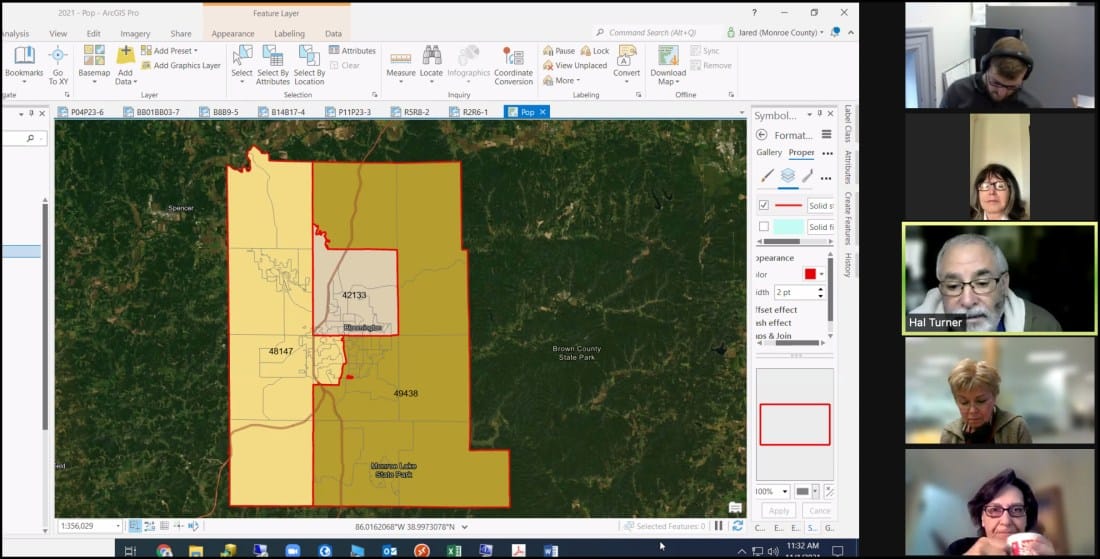Precinct boundary recommendations sent to Monroe County commissioners, as committee shifts focus to district lines


Seven revisions to current precinct lines in Monroe County are being recommended by a four-person committee appointed to give advice to county commissioners on precinct and district boundaries.
It was at their Monday meeting, after two weeks of work, when committee members settled on the recommendations, some of which could be considered technical.
The committee’s seven recommendations on precinct boundaries have been added to the regular meeting agenda for the county commissioners on Wednesday (Nov. 3)—just as a discussion item.
The Wednesday work session, when commissioners were originally expected to review the changes, has been cancelled.
That will set up the commissioners to vote on the precinct boundaries at their meeting the following week, on Nov. 10. That means Monroe County should be able to hit the Nov. 12 deadline set by the state elections division for changes to precincts.
The state’s deadline for county council and county commissioner district boundary changes is in about two months, on Dec. 26.
The Precinct boundary changes recommended by the committee are defined in terms of census blocks. So the summary documents include lists of census blocks that are proposed to be shifted from one precinct to another. (Precincts are named with the formula [township name] [precinct number].)
Under one of the proposed changes, two census blocks would move from Bloomington 17 to Bloomington 14, so that Bloomington 17 is no longer split by the SR 45-46 bypass.
The mapping tool that county GIS staff have created to support the committee’s work includes a layer for census blocks. So it’s possible to navigate on the map to those two blocks—which are numbered 181050006021005 and 181050006021006—and see that their populations, as measured by the 2020 census, are 93 and 10, respectively.
But it’s not population totals that are important for determining precincts. For precincts, the key is the number of active voters.
Another kind of change recommended by the committee would help eliminate some discontiguous bits of precincts. An example discussed in detail at a committee meeting last Thursday would merge a small castle-shaped part of Perry 04, consisting of three census blocks, into Perry 23.
At their Monday meeting this week, after dispatching the precinct boundary recommendations, committee members switched gears from precincts to council and commissioner boundaries. That meant switching focus from the number of active voters in an area to the total population.
Statutory requirements for precincts are based on active voters—because precincts are tied to the logistics of voting. Consideration of the total population is more of a concern for voter districts, because districts are tied to the population that is represented by an elected official.
At Monday’s meeting, committee member Regina Moore, who served for several years as Bloomington’s city clerk, drew out a key difference between the three county commissioner districts and the four county council districts. County councilors are elected just by the voters in their district—which is probably the most familiar type of scenario. In contrast, even though county commissioners have to reside in the district they represent, they’re elected by all voters countywide.
Commissioner District 2 looks exactly like Bloomington Township, because it consists of just those precincts in Bloomington Township.
District 1 and District 3 cover the western and eastern part of the county, respectively.
Based on the 2020 census, the populations of the three districts break down like this: District 1 (48,147); District 2 (42,133); and District 3 (49,438). The relatively smaller population for District 2, which includes much of the city of Bloomington, is probably due to the decrease in Bloomington’s population, as measured by the 2020 census.
For the 2020 census populations, the variance between the three districts—defined by the difference between the maximum and minimum, divided by the average—is about 16 percent. A rule of thumb, which was used as a target by the Bloomington city council in its redistricting process in 2012, was a variance of no more than 10 percent.
It’s not clear from Thursday’s discussion how the committee will want to proceed, in its attempt to balance the populations of the three commissioner districts. Moore floated the idea of rethinking the current east-west splitting of the county and instead possibly exploring a north-south division for commissioner districts.
In any case, the basic building blocks—for commissioner and county council districts alike—will be precincts, not census blocks. One approach to balancing things out would be to shift a precinct or two, from the existing District 1 and District 3, into District 2.
The Nov. 3 meeting of the county commissioners, when they’ll have precinct boundaries as a discussion item, starts at 10 a.m.




Comments ()